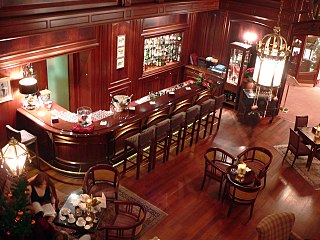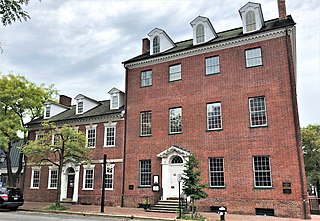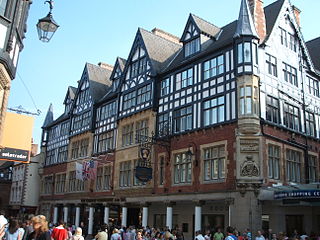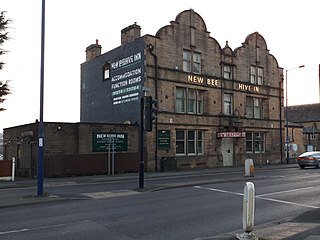
A pub is a drinking establishment licensed to serve alcoholic drinks for consumption on the premises. The term first appeared in the late 17th century, to differentiate private houses from those open to the public as alehouses, taverns and inns. Today, there is no strict definition, but CAMRA states a pub has four characteristics:
- is open to the public without membership or residency
- serves draught beer or cider without requiring food be consumed
- has at least one indoor area not laid out for meals
- allows drinks to be bought at a bar

A bar, also known as a saloon, a tavern or tippling house, or sometimes as a pub or club, is an establishment retail business that serves alcoholic beverages, such as beer, wine, liquor, cocktails, and other beverages such as mineral water and soft drinks. Bars often also sell snack foods, such as crisps or peanuts, for consumption on their premises. Some types of bars, such as pubs, may also serve food from a restaurant menu. The term "bar" refers to the countertop where drinks are prepared and served, and by extension to the overall premises.

Gadsby's Tavern is a complex of historic buildings at 134 and 138 North Royal Street at the corner of Cameron Street in the Old Town district of Alexandria, Virginia. The complex includes a c.1785 tavern, the 1792 City Tavern and Hotel, and an 1878 hotel addition. The taverns were a central part of the social, economic, political, and educational life of the city of Alexandria at the time. Currently, the complex is home to Gadsby's Tavern Restaurant, American Legion Post 24, and Gadsby's Tavern Museum, a cultural history museum. The museum houses exhibits of early American life in Virginia, and the restaurant operates in the original 1792 City Tavern dining room, serving a mixture of period and modern foods.

Mansfield railway station serves the town of Mansfield in Nottinghamshire, England. It was also known as Mansfield Town, to distinguish itself from the GCR's former Mansfield Central and Mansfield Woodhouse stations. It is a stop on the Robin Hood Line, located 17 miles (27 km) north of Nottingham; it is managed by East Midlands Railway. The station building is Grade II listed.

George IV Bridge is an elevated street in Edinburgh, Scotland, and is home to a number of the city's important public buildings.

The Chester Grosvenor Hotel is a hotel in Chester, Cheshire, England. The Grade II listed building was built between 1863 and 1865 and is owned by the Duke of Westminster.

The Royal Pavilion Tavern, commonly known as the Pavilion Tavern or Pav Tav and since February 2022 as The Fitz Regent, is a pub in the centre of Brighton, part of the English coastal city of Brighton and Hove. Converted from a house into the Royal Pavilion Hotel in the early 19th century, its original role soon changed from a hotel to a pub, in which guise it remained until its closure in September 2019. It reopened under its new name, but still in the ownership of the Mitchells & Butlers chain, on 13 February 2022. The building was also used as a court for several years early in its history, and prominent local architect Amon Henry Wilds was responsible for its redesign as a hotel and inn. English Heritage has listed the building at Grade II for its architectural and historical importance, and it stands within a conservation area.

The Falcon is a Grade II listed public house at 2 St John's Hill, Battersea, London.

The Magdala, also known as The Magdala Tavern or colloquially as simply The Magy, is a pub on South Hill Park in Hampstead, north London. Named after the British victory in the 1868 Battle of Magdala, it was the site of a notorious murder in 1955.

The Old Bell Hotel in Derby, Derbyshire, United Kingdom, is one of Derby's oldest and largest coaching inns. It was is built in 1650, in the historic street of Sadler Gate in the city's Cathedral Quarter. The hotel is a Grade II listed building and is included in the Derby City Statutory List of Buildings of Special Architecture or Historic Interest. Although much of the building has been altered and restored, most of the original structure can still be seen from the street, consisting of a timber-framed building of four storeys with four gables, each with one window, at the top. Over the years The Old Bell Hotel has served as a coaching inn, hotel, bar, restaurant, doctors' surgery, courtroom, jail and other functions.

The Kings Arms is a pub lying by the River Ouse in the city centre of York, in England.

1 Museum Street is a historic building in the city centre of York, in England.

3 St Helen's Square is a historic building in the city centre of York, in England.

The New Beehive Inn is a former pub in Bradford, England. It was built by Bradford Corporation in 1901 to replace an existing public house of the same name that they had purchased in 1889 and demolished to widen a road. The corporation intended to run the pub itself but instead let it out and sold it in 1926. It has since been run by a number of brewery companies and individuals. The pub contained many features dating to its construction and a significant refurbishment in 1936 and was described by the Campaign for Real Ale as "one of the country's very best historic pub interiors".

Ye Olde White Harte is a public house in Hull, England. It was built around 1660 in the Artisan Mannerist style but did not become a pub until the 1730s. In the aftermath of the Glorious Revolution of 1688 it was the site of a successful plot to remove the Catholic Governor of Hull. The pub was remodelled in 1881 in the Romantic style with extensive alteration to the interior and façade. At least two residents have suffered fatal accidents in the pub and it is reputed to be "one of Hull's most haunted".

The Golden Ball is a pub in the Bishophill area of central York, in England.

The Bath Hotel is a pub in Broomhall district of Sheffield, in England.

Roots is a restaurant on Marygate, just north of the city centre of York in England.



















